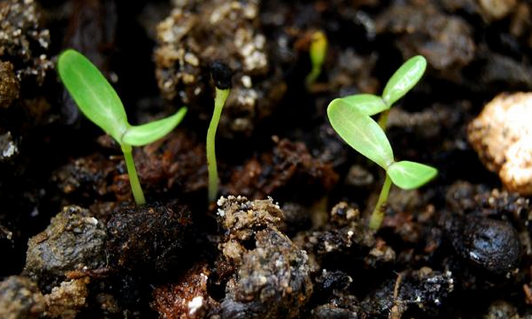The seed germination test is an important basis for determining whether a vegetable seed can be seeded and used. If the germination rate is low, it cannot be seeded. As spring is coming, it is necessary to learn to plant germination tests for vegetables. The method is described below.
Germination bed material preparation. There are two kinds of germination beds: paper bed and sand bed. Paper bed: generally adopts filter paper with good strength and texture, strong water absorption, good water retention, non-toxic and sterile, clean and free of soluble pigment, absorbent paper as paper bed; sand bed is small and uniform, its straight It is 0.05-0.8mm. Washing and high temperature sterilization must be performed before use.
Germination bed selection. Amaranth, tomato, radish, kale, cabbage, spinach and other small seeds such as pumpkin and loofah are selected from paper bed, large seeds such as beans are selected from sand bed or paper, cucumber, Chinese cabbage, eggplant, celery, lettuce, pepper and other seeds are used. Beds and sand beds are available.
Seed sampling. Randomly count 400 capsules from well-mixed seeds, usually 100 pellets for one replicate, and larger seeds can be further divided into 50 pellets, or even 25 pellets for one replicate.
The paper bed seeds are placed. The paper bed includes paper or paper. Germinating bed on paper: Place one or two layers of paper in a petri dish, and evenly discharge the seeds on the paper, keeping a certain distance between the grains and the grains. Germinating bed seed between papers: Place the seeds evenly on wet germinated paper and cover the seeds with another piece of paper.
Place the sand bed seeds. The seeds are pressed into the surface of the sand, or the seeds are sown on a layer of flat wet sand, and then 10-20 mm thick loose sand is applied according to the size of the seeds, and the seeds are evenly arranged on the wet germination bed, and the grains and the grains are kept constant. distance.

Germination culture. According to the characteristics of the germinated bed and the seed, the amount of water added to the germination bed is determined. For example, the amount of water added to the sand bed is 60%-80% of the saturated water, and the large seed such as beans is 80%; if the paper bed is sucked, the excess is drained. The water can be used, and the germination bed is always moist during germination. Keep germination during the darkness, celery and carrots are required to maintain dark conditions; at the same time, there is enough air around the seeds, pay attention to ventilation, control the temperature of 20 °C -25%, often pay attention to check, if the moldy seeds should be taken out and rinsed, If the mold is severely moldy, the germination bed should be replaced. Some crop seeds have physiological dormancy, and it is necessary to use the following methods before the test. Pre-freezing: Each replicate seed is applied to a wet germination bed prior to testing, seed treatment is carried out between 5 °C and 10 °C, and then germination is carried out at a prescribed temperature. The crop seeds that need to be pre-frozen are: leek, arborvitae, non-heading cabbage (cabbage, seaweed moss, vegetable moss, etc.), leaf mustard, stem mustard, Brassica napus, cabbage, lettuce, etc.; Liquid treatment: At the beginning of germination, the germination bed can be wetted with a 0.2% (m/v) potassium nitrate solution. Water may be humidified when the water is insufficient during the test. The crop seeds that need to be treated with potassium nitrate are mainly peppers, sweet peppers, tomatoes, and the like.
Calculate the germination rate. After germination and cultivation, the first count days and the last count days: pepper and eggplant, melon, melon on the 7th and 14th day; watermelon on the 5th and 14th day; cucumber, pumpkin, zucchini on the 4th and 8th day; Loofah, bitter gourd, melon, leek on days 4 and 14; tomato on days 5 and 14; kidney beans on days 5 and 9; beans on days 5 and 8; Brassica napus on day 5 and Day 7; carrots on days 7 and 10; no cabbage, leaf mustard, stem mustard, cabbage cabbage, rapeseed on days 5 and 7; cabbage, stalk, Brussels sprouts , broccoli day 5 and day 10. When counting the number of germinated seeds, those who have no roots or roots without buds; those with roots without root hair are linear or edema; those whose seeds are rot can not germinate; those with young roots and buds deformed; legumes, crosses Before the leaves of the flower family such as the flower family, the cotyledons fall off or the two cotyledons are broken by 2/3 or more, they cannot be used as germinating seeds, but should be counted as non-germinated seeds. The germination rate can be obtained by dividing the number of germinations by the number of whole seeds. According to the level of germination rate, it is determined whether the seed and seed size can be used. If the germination rate is low, the seed amount should be appropriately increased.
Other Specific Function Centrifuge
Other Specific Function Centrifuge,Pcr Plate Centrifuge,Specific Function Centrifuge,Medical Refrigerated Centrifuge
Guangdong Widinlsa International Co.Ltd , https://www.guangdongwidinlsa.com